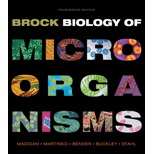
Brock Biology of Microorganisms (14th Edition)
14th Edition
ISBN: 9780321897398
Author: Michael T. Madigan, John M. Martinko, Kelly S. Bender, Daniel H. Buckley, David A. Stahl, Thomas Brock
Publisher: PEARSON
expand_more
expand_more
format_list_bulleted
Concept explainers
Question
Chapter 29.1, Problem 2MQ
Summary Introduction
Globally, four million people were killed by acute respiratory infections every year, specifically in developing countries. Respiratory diseases are considered as most common of all human diseases. The major vehicle that transmits the respiratory infection from one person to the other is called aerosol. Aerosols are generated by coughing, sneezing, and talking. Respiratory infections spread very rapidly, specifically in congested areas.
Expert Solution & Answer
Want to see the full answer?
Check out a sample textbook solution
Students have asked these similar questions
Please draw in the missing answer, thank you
Please fill in all blank questions, Thank you
please fill in missing parts , thank you
Chapter 29 Solutions
Brock Biology of Microorganisms (14th Edition)
Ch. 29.1 - Why can it be said that respiratory pathogens have...Ch. 29.1 - Prob. 2MQCh. 29.2 - Prob. 1MQCh. 29.2 - What is the primary virulence factor for...Ch. 29.3 - Prob. 1MQCh. 29.3 - What measures can be taken to decrease the current...Ch. 29.4 - Why is Mycobacterium tuberculosis a widespread...Ch. 29.4 - Prob. 2MQCh. 29.5 - Identify the symptoms and causes of meningitis.Ch. 29.5 - Describe the infection by Neisseria meningitidis...
Ch. 29.6 - How do the genomes of the measles virus and the...Ch. 29.6 - Describe the potential serious outcomes of...Ch. 29.6 - Identify the effects of immunization on the...Ch. 29.7 - Prob. 1MQCh. 29.7 - Discuss the possibilities for effective treatment...Ch. 29.8 - Distinguish between antigenic drift and antigenic...Ch. 29.8 - Prob. 2MQCh. 29.9 - What is the normal habitat of Staphylococcus...Ch. 29.9 - Prob. 2MQCh. 29.10 - Prob. 1MQCh. 29.10 - How can gastric ulcers be diagnosed? How can they...Ch. 29.11 - Prob. 1MQCh. 29.11 - Prob. 2MQCh. 29.12 - MINIQUIZ
• Explain at least one potential reason...Ch. 29.12 - Prob. 2MQCh. 29.13 - Prob. 1MQCh. 29.13 - Prob. 2MQCh. 29.14 - Prob. 1MQCh. 29.14 - Prob. 2MQCh. 29.14 - Prob. 3MQCh. 29 - Prob. 1RQCh. 29 - Prob. 2RQCh. 29 - Prob. 3RQCh. 29 - QDescribe the process of infection by...Ch. 29 - QDescribe the symptoms of meningococcemia and...Ch. 29 - Prob. 6RQCh. 29 - QWhy are colds such common respiratory diseases,...Ch. 29 - Prob. 8RQCh. 29 - QDistinguish between pathogenic staphylococci and...Ch. 29 - QDescribe the evidence linking Helicobacter pylori...Ch. 29 - Prob. 11RQCh. 29 - REVIEW QUESTIONS
12. Why did the incidence of...Ch. 29 - REVIEW QUESTIONS
13. For the sexually transmitted...Ch. 29 - REVIEW QUESTIONS
14. Describe how human...Ch. 29 - Prob. 1AQCh. 29 - Application Questions
Why does active tuberculosis...Ch. 29 - APPLICATION QUESTIONS
3. Your college roommate...Ch. 29 - APPLICATION QUESTIONS
4. Contrast an HIV infection...Ch. 29 - Prob. 5AQCh. 29 - APPLICATION QUESTIONS
6. As the director of your...
Knowledge Booster
Learn more about
Need a deep-dive on the concept behind this application? Look no further. Learn more about this topic, biology and related others by exploring similar questions and additional content below.Similar questions
- please draw in the answers, thank youarrow_forwarda. On this first grid, assume that the DNA and RNA templates are read left to right. DNA DNA mRNA codon tRNA anticodon polypeptide _strand strand C с A T G A U G C A TRP b. Now do this AGAIN assuming that the DNA and RNA templates are read right to left. DNA DNA strand strand C mRNA codon tRNA anticodon polypeptide 0 A T G A U G с A TRParrow_forwardplease answer all question below with the following answer choice, thank you!arrow_forward
- please draw in the answeres, thank youarrow_forwardA) What is being shown here?B) What is indicated by the RED arrow?C) What is indicated by the BLUE arrow?arrow_forwardPlease identify the curve shown below. What does this curve represent? Please identify A, B, C, D, and E (the orange oval). What is occurring in these regions?arrow_forward
- Please identify the test shown here. 1) What is the test? 2) What does the test indicate? How is it performed? What is CX? 3) Why might the test be performed in a clinical setting? GEN CZ CX CPZ PTZ CACarrow_forwardDetermine how much ATP would a cell produce when using fermentation of a 50 mM glucose solution?arrow_forwardDetermine how much ATP would a cell produce when using aerobic respiration of a 7 mM glucose solution?arrow_forward
- Determine how much ATP would a cell produce when using aerobic respiration to degrade one small protein molecule into 12 molecules of malic acid, how many ATP would that cell make? Malic acid is an intermediate in the Krebs cycle. Assume there is no other carbon source and no acetyl-CoA.arrow_forwardIdentify each of the major endocrine glandsarrow_forwardCome up with a few questions and answers for umbrella species, keystone species, redunant species, and aquatic keystone speciesarrow_forward
arrow_back_ios
SEE MORE QUESTIONS
arrow_forward_ios
Recommended textbooks for you
- Understanding Health Insurance: A Guide to Billin...Health & NutritionISBN:9781337679480Author:GREENPublisher:Cengage
 Medical Terminology for Health Professions, Spira...Health & NutritionISBN:9781305634350Author:Ann Ehrlich, Carol L. Schroeder, Laura Ehrlich, Katrina A. SchroederPublisher:Cengage Learning
Medical Terminology for Health Professions, Spira...Health & NutritionISBN:9781305634350Author:Ann Ehrlich, Carol L. Schroeder, Laura Ehrlich, Katrina A. SchroederPublisher:Cengage Learning - Essentials of Pharmacology for Health ProfessionsNursingISBN:9781305441620Author:WOODROWPublisher:CengageBasic Clinical Lab Competencies for Respiratory C...NursingISBN:9781285244662Author:WhitePublisher:Cengage
 Microbiology for Surgical Technologists (MindTap ...BiologyISBN:9781111306663Author:Margaret Rodriguez, Paul PricePublisher:Cengage Learning
Microbiology for Surgical Technologists (MindTap ...BiologyISBN:9781111306663Author:Margaret Rodriguez, Paul PricePublisher:Cengage Learning

Understanding Health Insurance: A Guide to Billin...
Health & Nutrition
ISBN:9781337679480
Author:GREEN
Publisher:Cengage


Medical Terminology for Health Professions, Spira...
Health & Nutrition
ISBN:9781305634350
Author:Ann Ehrlich, Carol L. Schroeder, Laura Ehrlich, Katrina A. Schroeder
Publisher:Cengage Learning

Essentials of Pharmacology for Health Professions
Nursing
ISBN:9781305441620
Author:WOODROW
Publisher:Cengage

Basic Clinical Lab Competencies for Respiratory C...
Nursing
ISBN:9781285244662
Author:White
Publisher:Cengage

Microbiology for Surgical Technologists (MindTap ...
Biology
ISBN:9781111306663
Author:Margaret Rodriguez, Paul Price
Publisher:Cengage Learning